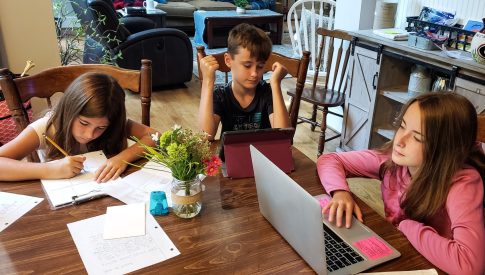Maths - Broad General Education (BGE) level 3/4 Index
Online Mathematic Lessons for broad general education Students in Scotland
- Whole Numbers
- Decimals
- Special Numbers
- Negative Numbers
- Fractions and Percentages
- Ratio
- Algebra
- Angles
- Symmetry
- Time
- Statistics
- Quadrilaterals
- Area
- Volume
- Patterns
- Scale Drawing
Multiplying and dividing negative numbers.
The rule for multiplying and dividing is very similar to the rule for adding and subtracting. When the signs are different the answer is negative. When the signs are the same the answer is positive. This lesson shows how to do this with easy-to-understand explanation.
Multiplying and dividing by multiples of 10, 100, and 1000:
Addressing the national curriculum aim, to solve problems involving multiplication and division including using their knowledge of factors and multiples of 10,100 and 1000. When we multiply by 10, 100 and 1000 we shift the digits to the left. One place left for 10, two places left for 100 and three places left for 1000. When we divide by 10, 100 and 1000 we do the opposite and shift the digits to the right instead. This lesson shows how to do this in an easy-to-understand format.
Mathematical Operations in context:
The intention of this lesson is to be able to solve problems using addition, subtraction, multiplication & division. The lesson is to decide the correct mathematical operations to solve real-life problems.
Time intervals:
A time interval is the amount of time between two given points in time. An example of this is: “The time interval between three o’clock and four o’clock is one hour.” A clock breaks time down into intervals of seconds, minutes, and hours. An interval is a distinct measure of time or the physical or temporal distance between two things.
Speed, distance and time:
The formula for speed is speed = distance ÷ time. To work out what the units are for speed, you need to know the units for distance and time. In this example, distance is in metres (m) and time is in seconds (s), so the units will be in metres per second (m/s). An easy way to remember the formulae is to put distance, speed and time (or the letters D, S and T) into a triangle. This lesson demonstrates how.
Percentages:
By using grids of 100 squares to demonstrate percentages, teachers can demonstrate the “parts” and the “whole. ‘ If the students colour 15 small parts out of 100, they can visualize 15 percent. If they colour in all 100 parts, then they have coloured 100 percent of the grid or an entire large square.
Fractions, decimals and percentages:
Equivalent fractions, decimals, and percentages are all just different ways of representing the same thing, so you can convert between them to compare. Make connections between fractions and previous work on decimals. Learn common fraction and decimal equivalences.
Fractions: fractions lesson includes: classify fractions; equivalent fractions; simplify; compare and order; convert fractions to mixed numbers. Students learn how to add fractions with different denominators. Number: Interactive Lessons · Dividing Fractions and Mixed Numbers.
Negative numbers in context:
Negative numbers in context. In this lesson, we interpret negative numbers in a variety of contexts and explore movement on an ‘extended’ number line, use the space counting method to work out differences between values.
Problems using BODMAS:
BODMAS stands for Bracket, Of, Division, Multiplication, Addition and Subtraction. Worked-out problems for solving BODMAS rules in this lesson.
Rounding to the nearest 10, 100, 1000: the rule for rounding is always look at the digit to the right of the one you’re supposed to be rounding to: if it is 5 or more, then round it up if it is less than 5, then round it down.
Rounding decimal places: look at the first digit after the decimal point if rounding to one decimal place or the second digit for two decimal places. draw a vertical line to the right of the place value digit that is required. Look at the next digit. if it’s 5 or more, increase the previous digit by one.
Multiplying by multiples of 10, 100, 1000: addressing the national curriculum aim, to solve problems involving multiplication using their knowledge of factors and multiples of 10,100 and 1000. When we multiply by 10, 100 and 1000 we shift the digits to the left. One place left for 10, two places left for 100 and three places left for 1000.
Multiplying and dividing by multiples of 10, 100, 1000: addressing the national curriculum aim, to solve problems involving multiplication and division including using their knowledge of factors and multiples of 10,100 and 1000. When we multiply by 10, 100 and 1000 we shift the digits to the left. One place left for 10, two places left for 100 and three places left for 1000. When we divide by 10, 100 and 1000 we do the opposite and shift the digits to the right instead. This lesson will show how to do this in an easy-to-understand format.
Adding, subtracting, multiplying and dividing: imagine a number line. When adding positive numbers, count to the right. When subtracting positive numbers, count to the left. When subtracting negative numbers, count to the right. This lesson will demonstrate this in action. This lesson also includes teaching and exercises about the relationship between multiplication and division.


"It's bright and colourful, easy to read, and extremely easy to use unlike most textbooks or online learning websites" Daisy, S3 PupilSign Up & Learn Today

